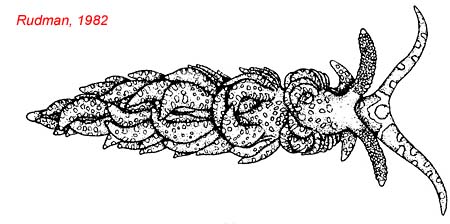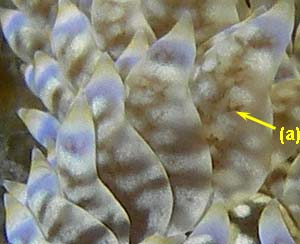This species has been observed on Reunion and Mayotte Islands
Species characteristics : Background colour is brown or brownish-green with a pattern of light, sometimes whitish patches over cerata and body. Also a distinctive pattern of bands on the head The background colour is caused by the contents of fine branches of the digestive gland which ramify throughout the body wall There is broad yellowish band just below the tip of the cerata. In some specimen there is a blue to purplish band below the yellow band. White cap tip the cerata The rhinophores are papillate except for a narrow line down the anterior midline which devoid of papillae. |

|
|
| Showing species characteristics... | Photo Stephane Ciccione Réunion, "Kelonia center", at Saint Leu, 31 March 2009, size : 60 mm |
|
Remarks :
Identification confirmed by Nathalie Yonow
Synonynymous : (according Rudman, 1982)
- Baeolidia major, Eliot, 1903
- Baeolidia major amakusana, Baba, 1937
- Berghia major (Eliot, 1903)
- Spurilla major (Eliot, 1903)
There are two very similar species Baeolidia moebii and Baeolidia australis but they have some differences.
Distrinbution : Tropical iIndo West Pacific Distribution : Australie and Red seaa Cerata : There is a broad yellowish band just below the tip of the cerata . In some specimen there is a blue to purplish band below the yellow band.
The cerata are leaf-like and flattenedCerata : Below the tip is a thin, bright orange band, and a broad blue band which completely rings the cerata . The lower edge of this blue band is irregular, the blue gradually diffusing into the brown.
The cerata are leaf-like and flattened but somewhat swollenHead : There is (sometimes) a distinctive large patch, dark green brown , at the anteriro midline, surrounded by a light, whitish ring.
Head : There is (sometimes) a distinctive large patch, blue , at the anteriro midline, surrounded by a light, whitish ring.
Rhinophores : They are papillate exept for a narrow line down the anterior midline which devoid of papillae.
Rhinophores : They are large and papillate, bearing papillae both anteriorly and posteriorly . They are darker.
Head : There are two bumps (divided swellings ) at the front of the head
Head : No bumps (divided swellings) at the front of the head
According to N. Yonow , the Reunion Island specimens, looks like more Baeolidia moebii than Baeolidia australis because the presence of divided swelling on the head...
For some people (Nathalie Yonow, Bill Rudman) B. australis is probably just a form of the much less colourful Baeolidia moebii and in that case "moebii" is the older name...
Bibliographic data :
The cerata are translucent with the brown or grennish brown of the dendritic digestive gland showing through
The pre pericardial cerata are arranged in a sloping arch on each side , the anterior limb starting just below the rhinophore
The genital opening is just below the right pre pericardial arch and the anus opens in the first post pericardial arch on the right
Behind the pericardium, on each side, the cerata are arranged in three single rowed arches and a serie of up to six rows.
The oral tentacle are translucent with many tiny brown specks within the epidermal tissues. Light bands and patches traverse the oral tentacle and there is a distinct light band across the base of each tentacle.
The rhinophores are pale watery brown with darker brown tubercles. On close examination one can see brown ducts going up to the stalk and branching into the papillae.
The anterior edge of the foot has a deep lateral groove forming a distinct upper veil. This veil is split by a median notch. The anterior corners of the foot extend into angular processes.
Its particular food is a small brown sea anemone Cricophorus nutrix which is usually found living attached to subtidal brown algae. Consequently, It is normally found crawling on or amongst brown algae.
When the aeolids eat the sea anemones they store the zooxanthellae in special ducts connected to their digestive systems, where they are kept alive and "milked" of the sugars they produce when they photosynthesise. The brown network pattern are a network of ducts in the skin which contain brown zooxanthellae.
The light coloured form corresponded to an animal in which the zooxanthellae in its body is very sparse, while the dark brown version is an animal with many healthy zooxanthellae.
References :
Bill Rudman Seaslug site : Sea Slug Forum : Spurilla australis or major
Nudipixel Baeolidia major
Publications :
Rudman, W.B. (1982) The taxonomy and biology of further aeolidacean and arminacean nudibranch molluscs with symbiotic zooxanthellae. Zoological Journal of the Linnean Society, 74: 147-196.
Other photos of Baeolidia moebii :
.jpg) |
Paul Giannasi Mayotte, cage aquacole de Longoni, 12 m, 12 December 2016, size : 35-40 mm
|
Philibert Bidgrain "Kelonia center", at Saint Leu, 1 April 2009, size : 60 mm (specimen found by Stephane Ciccionne) |
Background colour is brown or brownish-green with a pattern of light, sometimes whitish patches over cerata and body. Also a distinctive pattern of bands on the head |
 |
|
 |
Philibert Bidgrain "Kelonia center", at Saint Leu, 23 March 2009, size : 60 mm (specimen found by Stephane Ciccionne) The anterior edge of te foot has a deep lateral groove (b) forming a distinct upper veil. This veil is split by a median notch (c) forming two bumps (divided swellings). The anterior corners (a) of the foot extend into angular processes. The rhinophores are pale watery brown with darker brown tubercles (d). On close examination one can see brown ducts (e) going up to the stalk and branching into the papillae.
|
Philibert Bidgrain "Kelonia center", at Saint Leu, 23 March 2009, size : 60 mm (specimen found by Stephane Ciccionne)
In this photo, we can clearly see, below the white tip, a yellowish band (a), We can probably see through the essentially translucent body wall the mass egg (b)  |
 |
 |
Philibert Bidgrain "Kelonia center", at Saint Leu, 23 March and 1 April 2009, size : 60 mm (specimen found by Stephane Ciccionne) We can see through the essentially translucent body wall in the cerata (a) and the foot sole (b) a brown coloration. The brown network pattern are a network of ducts in the skin which contain brown zooxanthellae.
|
Kate Ferrer Reunion, Saint Pierre lagoon, less 1 m, 11 April 2012, size : 20 mm
There is broad yellowish band just below the tip of the cerata and white cap tip the cerata In this specimen there isn't a blue to purplish band below the yellow band.
|
 |
More photos from Indian Ocean
Reunion, Spurilla major, at Etang salé, by Seb Vasquez



